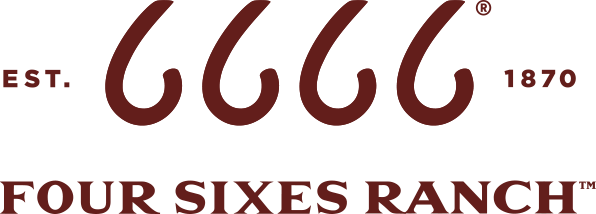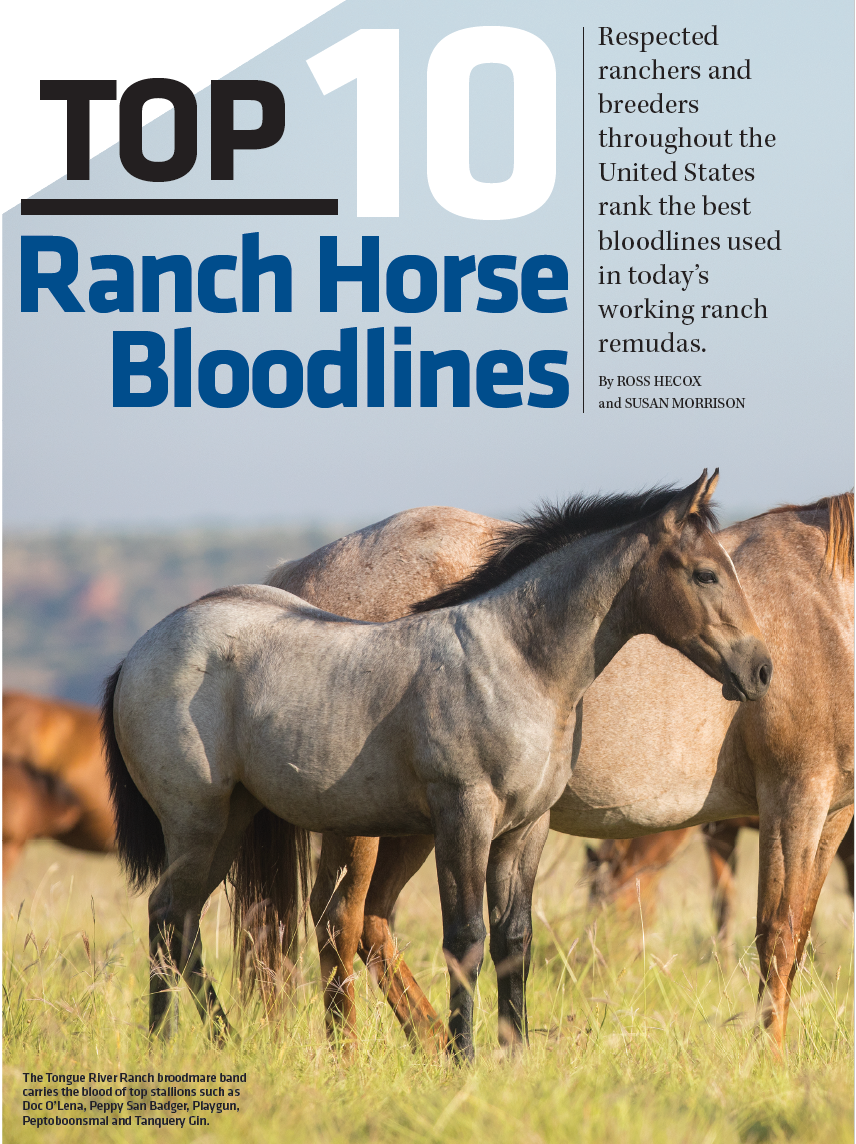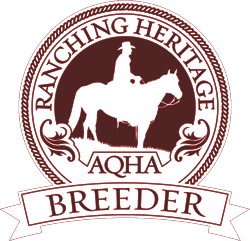Western Horseman
October 2019
By Ross Hecox and Susan Morrison
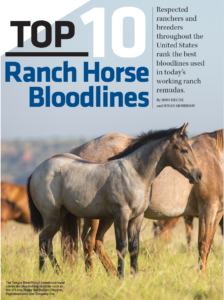
ASK RANCHERS OR BREEDERS to list the bloodlines that influence their horse programs, and you will likely receive a comprehensive list of sires, dams, granddams and grandsires. Even though studying a five-generation pedigree gives you the raw facts on a horse’s breeding, there’s no comparison to hearing people rave about the outstanding stallions and mares that are on their horses’ registration papers. A breeder might highlight a certain mare on the bottom side of the pedigree who produced a number of impressive foals, while another might remind you how a certain stallion two or three generations back earned a substantial amount of money in competition.
This Top 10 list of ranch horse bloodlines was compiled based on the insights and opinions of respected ranch horse breeders and industry professionals. We called dozens of people, from Texas to California, and from Montana to New Mexico, asking what bloodlines are most prevalent in today’s ranch horses. We also asked them to list bloodlines that they admire the most for handling everyday ranch work. We then compiled their answers to develop this top 10 ranking.
Our sources stressed the importance of balanced conformation, sizeable bone, hard feet and prominent withers in their ranch horses. They agreed that cow sense, athletic ability and stamina are critical traits. And they invariably gave names of specific stallions when listing their top bloodlines, even though most agreed that the dam contributes as much, if not more, to her foal. Quite simply, stallions carry much more name recognition due to marketing and number of offspring.
Some stallions perform so well as sires and grandsires that their names remain recognizable for generations. For example, Driftwood was foaled in 1932, yet some ranchers still mention the famous stud when referencing the bloodlines of their horses today. Other stallions perform so well that their outstanding sons and grandsons in some ways steal their spotlight. Colonel Freckles and Playgun are often cited when breeders list top ranch horse bloodlines; both horses descend from the legendary Sugar Bars, foaled in 1951. Finally, some stallions might sire a horse that rises to the level of being referenced often himself, yet the sire continues to make his own contributions through other sons, daughters and grandget. A good example is Peppy San Badger and his son Peptoboonsmal, and it illustrates how a sire and his son both can make a Top 10 bloodlines list.
Whether foaled during the Great Depression or near the turn of this century, these horses rank among the top 10 bloodlines making an impact on today’s working ranch horses.

10 – Tanquery Gin
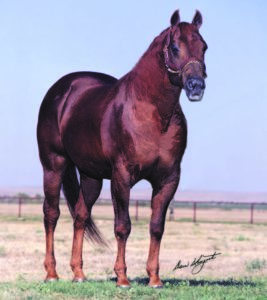
BRED AND RAISED by iconic Texas horseman B.F. Phillips, Tanquery Gin was trained by legendary cutting horse trainer Shorty Freeman. Although his show career in cutting was hampered by injuries, the 1975 stallion displayed enough talent in front of a cow to attract mare owners. Two foals from his first foal crop combined to win more than $450,000 in cutting competition. The sorrel continued to sire impressive foals under the ownership of Georgia breeder William S. Morris III. His impact as a ranch horse sire no doubt grew after he was purchased by the Four Sixes Ranch in Guthrie, Texas, in 1996. Tanquery Gin sired earners of more than $2.3 million, but may be better known as a great broodmare sire. His daughters have produced 266 performers with earnings of more than $3 million. Glenn Blodgett, DVM, the Four Sixes horse division manager, says that Tanquery Gin also sired many top-notch ranch geldings. “They had all the traits you would want in a ranch horse,” Blodgett says. “They had stamina and athletic ability, they stayed sound, and everyone got along with them. When you look at the influence Tanquery Gin had on the Sixes program, he was really a dominant horse.”

9 – Shining Spark
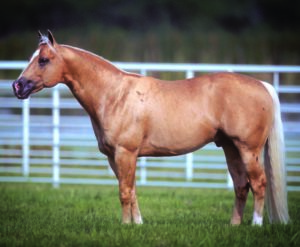
A NATIONAL REINING HORSE Association Derby champion, an American Quarter Horse Association junior reining world champion, sire of multiple champions in reining, working cow horse and roping, the son of AQHA Superhorse Diamonds Sparkle, and a stunning palomino to boot: That is Shining Spark. Breeder and owner Carol Rose of Gainesville, Texas, once said it was impossible to promote Shining Spark as a stallion sire or broodmare sire, because he sired both. Looking at his Equi-Stat offspring records, 32 of his leading 35 offspring also have produced money-earners. He has consistently ranked at or near the top among sires of reining horses and reined cow horses. Even more than their accomplishments in the arena, their trainability, athletic ability and good bone endear them to ranchers. Tom Moorhouse utilized a son of Shining Spark on his Texas ranch for nearly 20 years. Seven S Shining Gold, or “Waurika,” was known for siring intelligent foals with plenty of stamina. “He and his foals had a good bit of bottom,” Moorhouse says. “And they had good cow sense, were gentle, and had plenty of speed for roping cattle.”

8 – Paddys Irish Whiskey
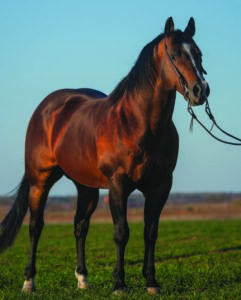
PADDYS IRISH WHISKEY’S ranching roots run deep. While owned by John Scott, he earned $12,000 in cutting competition before retiring to stud at Scott’s S Ranch in Montana. After siring dozens of ranch horses, the 1991 bay made headlines in 2000 when he sold for $560,000 at Scott’s dispersal sale in Billings, Montana. The Four Sixes Ranch purchased him and promptly syndicated him. Paddys Irish Whiskey has sired the winners of nearly $1.5 million, and his top five earners have succeeded in cutting, ranch versatility, reining, reined cow horse and roping events. The stallion also was part of a famous trio of brothers that included Gallo Del Cielo (“Rooster”) and Grays Starlight. His offspring were also more than capable handling ranch work, recalls Scott’s son, Jim. “They would just watch a cow so well that they were easy to train,” he says. “And they were tough; they could take riding long distances on the ranch and weren’t weak-hearted. I’d love to have [Paddys Irish Whiskey] back, I’ll put it that way.”
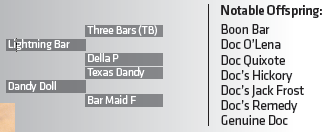
7 – Doc Bar
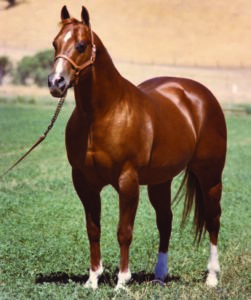
DOC BAR’S INFLUENCE in the cow horse world is amazingly prevalent. The majority of cutting and reined cow horse, as well as ranch horses, trace to the 1956 chestnut stallion. It wasn’t what his breeders, Tom and Jack Finley of Arizona, imagined when they bred a AA-rated race mare to a AAA-rated runner. Doc Bar won only $95 on the track, but he excelled in halter competition, winning nine grand championships. His offspring demonstrated uncanny athleticism and cow sense, and they dominated the cutting arena during the 1960s and 1970s. That prowess has continued for another five generations, and ranchers have infused Doc Bar bloodlines into their remudas for decades. In fact, six of the stallions ranked on this list have Doc Bar on their pedigrees. “We need to raise awfully good ranch horses, as far as ones that can get the job done in steep country, rough country and high country,” says California rancher John Lacey. “Most all of our horses go back to Doc Bar. He goes in just about every line of horses that does anything in ranch country, in the show ring and everywhere else.”

6 – Driftwood
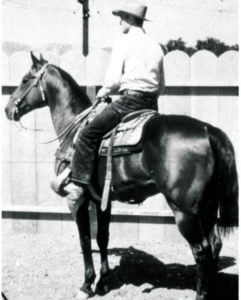
ALTHOUGH HE WAS BORN in 1932 near Silverton, Texas, and match-raced successfully throughout the Texas Panhandle as a young horse, Driftwood gained most of his fame in Arizona and California as a top rope horse in professional rodeos. The blood bay stallion known as “Speedy” earned a reputation for his intelligence, conformation, gentle disposition and quickness. He changed hands several times until 1943, when Channing and Katy Peake of Lompoc, California, purchased him and began breeding him to their mares. Driftwood proved himself as a great sire of roping horses, even though only 153 of his foals were registered with the American Quarter Horse Association because many of his offspring were born before the registry was founded. Not surprisingly, cowboys found that the cow sense, speed and durability of his foals translated well to ranch work, and to this day outfits such as Babbitt Ranches, the O RO and Haythorn Land & Cattle raise horses that trace to Driftwood. Although the stallion died in 1960, ranchers still proudly claim to use “Driftwood horses.” “The Driftwood lines would be the most predominant bloodlines we have,” says California rancher Joe Murray. “We need to raise a pretty substantial horse. We might rope 15 yearlings and cover 2,500 acres doing it, and it takes all day. So you’ve got to have a horse with some substance

5 – Colonel Freckles
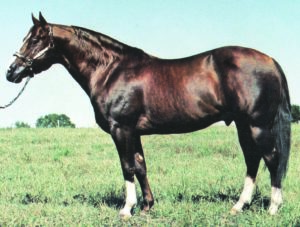
LIKE SEVERAL OTHER HORSES on this list, Colonel Freckles first made his mark at the NCHA Futurity, where in 1976 he won the open championship with Olan Hightower riding. A mare out of his first foal crop, Colonel Lil, went on to win the 1981 National Cutting Horse Association Futurity. It was a telltale sign that the stallion, owned by Lou and Wanda Waters of Texas during the latter part of his life, was going to be an outstanding sire. His son Nu Cash, shown by Ted Robinson, won the National Reined Cow Horse Association Snaffle Bit Futurity, and then sired three winners of the event’s open division. A grandson, Colonels Smoking Gun, was a reining champion who sired two National Reining Horse Association Futurity open winners. An AQHA Hall of Fame inductee, Colonel Freckles is the grandsire or great-grandsire of AQHA champions in roping, versatility ranch horse and all-around competition. That versatility—a horse’s ability to work a cow, run a reining pattern or work a rope—continues to make Colonel Freckles a sought-after name in a pedigree. “Versatility is the first word that comes to mind,” says Joni Hunt, whose family’s Open Box Rafter Ranch in South Dakota once stood a son of Colonel Freckles. “Sugar Bars crossed on Leo is such a successful and strong nick. It seems like those Colonel Freckles bloodlines show up in every discipline. They’re pretty horses, and it doesn’t take long to train them. They’re smart, willing and have a lot of natural cow sense.”
LEADING CUTTING SIRE Metallic Cat is poised to make an impact on ranch horse programs.
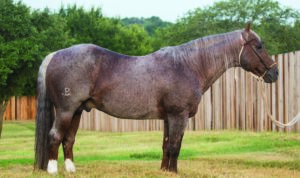
When asked what stallions would likely impact the ranching industry in the next decade, ranchers and breeders overwhelmingly named Metallic Cat. The cutting superstar’s athletic ability, willing disposition, intelligence, good
conformation and red roan color make him a standout, they agreed.
In 2008, at age 3, Metallic Cat and trainer Beau Galyean walked into the herd at the National Cutting Horse Association Futurity Open finals in Fort Worth, Texas. It was only the fourth time the stallion had been shown, counting the go-rounds. Anyone watching knew he was a special horse, but no one could have imagined how far he would go and how much he would impact the overall horse industry.
After capturing the Futurity Open championship, he went on to earn a total of $637,711. He was shown a total of 37 times and never lost a cow. By High Brow Cat and out of Chers Shadow by Peptoboonsmal, Metallic Cat was bred by The Roan Rangers Weatherford, Texas. Beau and Ashley Galyean purchased him when he was 2, and then the stallion sold to Alvin and Becky Fults as a 3-year-old. In 2017 Bobby Patton’s Rocking P Ranch purchased Metallic Cat, known as “Denver.” He stands at Brazos Valley Stallion Station in Stephenville, Texas.

His first foals were born in 2010 and quickly began making names for themselves in the show pen in 2013. His sire record now includes more than 62 horses with earnings of $100,000 or more, including four with more than $400,000 to their credit. Hashtags, out of the Dual Rey daughter Dual Rey Tag, leads the pack with $495,471. Call Me Mitch, with $173,746, is the leading reined cow horse sired by Metallic Cat. And he has sired earners in ranch horse/ranch versatility competition, barrel racing, reining and roping.
Outside of the show pen or rodeo arena, ranchers say the stallion’s intelligence, laid-back disposition, cow sense and sturdy conformation are being passed to his offspring, making him one of the most popular young sires in the industry. Metallic Cat’s sons also are proving themselves as ranch sires.
“We started breeding mares to Metallic Cat because he was handy and close, but the more we rode them, the more we liked them,” says Dick Cogdell, whose family owns Tule Ranch in Tulia, Texas, and also is active in the cutting industry. “If they don’t make a cutting horse they’re good-minded enough to rope on. We use a lot of them, and we like them.”
Cogdell owns two stallions by Metallic Cat, one who has several 2-year-olds that have been started this year and the other just beginning his breeding career.
“We’re pleased with the colts we’re riding,” he says.
Jann Parker, whose Billings Livestock Sales in Billings, Montana, are noted for quality ranch horses, says she is already seeing the influence of Metallic Cat in the area, as she did with the stallion’s sire, High Brow Cat.
“It goes back to this: Those horses sire horses that have a willing attitude and want to be your partner, and are gentle,” Parker says. “Plus with Metallic Cat you get the bonus of color. I think we’ll continue to see more of them as he dominates more than just the cutting horse pen.”

4 – High Brow Cat
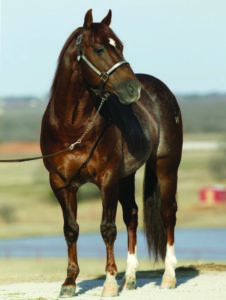
ALTHOUGH HE WON MORE than $100,000 in the cutting pen—a great accomplishment in itself—High Brow Cat always will be thought of as a prolific sire. His get have primarily won in cutting, but he has sired money earners in a variety of disciplines, including reining, working cow horse, barrel racing and ranch horse classes. Owned for much of his life by Jack Waggoner, High Brow Cat, now 31, was purchased in 2013 by Colt Ventures, and now is owned in a partnership with Beechfork Ranch. The stallion has consistently been at the top of the leading cutting sires list since his first foal crop began winning, and he now has earners of more than $81 million to his credit. He also has turned out to be an asset for ranchers, who have discovered he passes along not only athletic ability but willing minds. Horseman and rancher Ken McNabb of Lovell, Wyoming, owns a son of High Brow Cat, DM High Brow Prince, and says the stallion is proving himself quickly. “He is out of a money-earning daughter of Peppy San Badger and was born on the place,” he says. “When I started him he was phenomenal. We determined we’d let him produce a couple of foal crops and we got exactly the same thing. His colts are super kind, gentle, sensible, trainable and cowy.”

3 – Peptoboonsmal
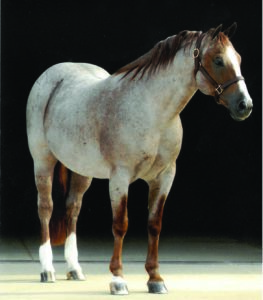
WITH A LEGEND FOR A SIRE, and a dam who has become an all-time leading producer of cutting horses with earners of $2.6 million, Peptoboonsmal was destined to become a great cutting horse. By Peppy San Badger and out of Royal Blue Boon, the 1992 red roan stallion won the NCHA Futurity in 1995 and soon became a leading sire in cutting and reined cow horse competition, with 902 earners of more than $27 million. Bred and owned for most of his life by Larry and Elaine Hall, Peptoboonsmal is now owned by the Aaron Ranch of Commerce, Texas. Although he was raised in Texas, his influence has reached all regions of the United States. Many working cattle outfits, such as the King Ranch, Spade Ranches and Tongue River Ranch, own sons of Peptoboonsmal because they like crossing the stout, thick-boned stallions on their broodmares. “We see a lot of Peptoboonsmals in our area,” says Nevada rancher and breeder Jymme Dominguez. “They are also our favorites because they are bigger, hardier, tougher horses, but still have the athletic abilities and cow sense it takes to make a good ranch horse.”

2 – Peppy San Badger
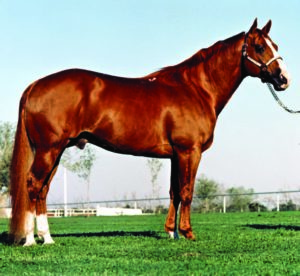
THIS 1974 STALLION was not only a National Cutting Horse Association Futurity champion, but also a solid ranch horse who spent plenty of time working cattle in the South Texas pastures of the famed King Ranch. Shown by Buster Welch, “Little Peppy” attracted attention in the show pen for his flashy looks and cow sense. His impact on the cutting industry was undeniable, as his offspring earned a combined $24.6 million. Through his sons and daughters, grandsons and granddaughters, and even beyond, the stallion remains popular. Although he’s been gone since 2005, Little Peppy’s blood still runs through many of today’s cutting horses, cow horses, stock horse competitors and ranch versatility winners. In fact, from 2008 through 2018, every American Quarter Horse Association Versatility Ranch Horse Open World Champion’s pedigree includes his name. Today’s ranchers and breeders often still look for Peppy San Badger on a horse’s registration papers. “If I were to breed to anything other than to my studs, I’d want it to have some Peppy San Badger influence. You can’t go wrong with Peppy San Badger horses,” says John Anderson of Muleshoe Ranch in Gail, Texas. “They’ve got bone, they’ve got muscle, they’ve got feet. They don’t break down and they’re cowy. They’re just catty and can get around. They’re all-around ranch horses.”

1 – Playgun
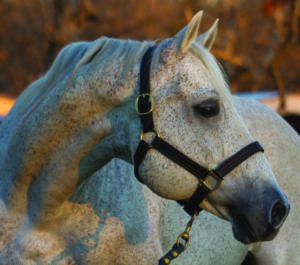
FOALED IN 1992, Playgun was purchased as a yearling by Dick and Brenda Pieper of Marietta, Oklahoma. He won more than $185,000 in cutting competition and sired the earners of more than $5 million in cutting, reining, reined cow horse, roping and ranch versatility competition. Ranchers throughout the United States recognized the stallion not only for his cow sense, ability, and prepotency as a sire; they also appreciated that his foals possessed the conformation, size and structural soundness to handle everyday ranch work. By the mid-2000s, prominent ranches such as the Four Sixes, Haythorn Land & Cattle and the Stuart Ranch were using sons of Playgun as their herd sires. Although the gray stallion died in 2015, he continues to influence ranching bloodlines. “There are a lot of great sons of Playgun that are used on the ranches,” says Nebraska rancher Craig Haythorn. “They have a little more bone, size and substance [compared to other cutting horses], and they still have all the cow and ability you need. In the last 10 years, I’d says that Playgun has supported ranch horse programs in several places.”
